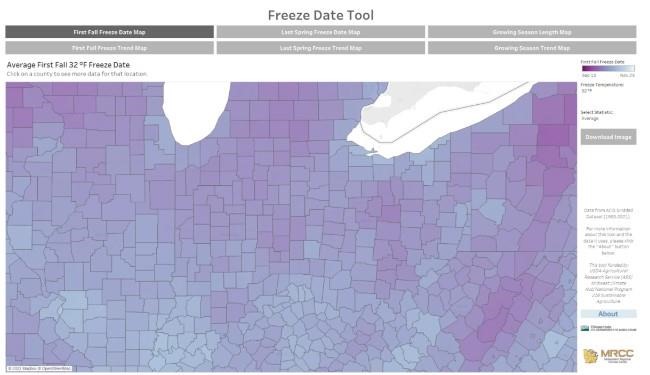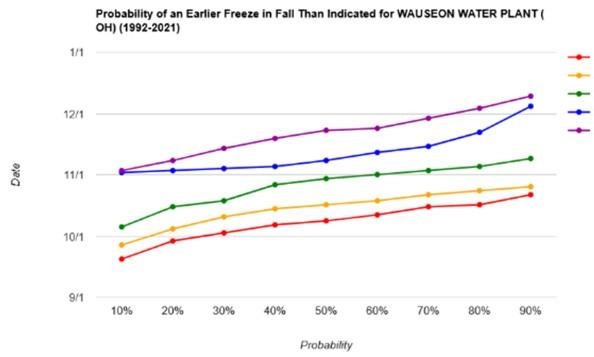By Aaron Wilson and Eric Richer
The calendar has turned to October, and with it, harvest and fall activities will accelerate over the next few weeks. We have already experienced a few chilly nights this past week with patchy frost in some areas, but when do we typically see our first freeze conditions? This first (last) official freeze is defined as the first fall (spring) day where the overnight low reaches 32°F.
The Midwest Regional Climate Center (MRCC) has developed a new Freeze Date Tool (https://mrcc.purdue.edu/freeze/freezedatetool.html) that relies on historical temperature data at the county level back to 1950 and allows users to select a freeze temperature threshold between 20°F and 40°F to visualize the earliest, average, and latest fall or spring event. For instance, many of us are interested in the hard freeze threshold of 28°F, the temperature at which our corn and soybean growing season comes to an end.
Figure 1 shows the average first fall freeze date for areas of the eastern corn belt for the period 1950-2021 using the 32°F threshold. The online version allows users to hover their mouse over a county of choice to view the average freeze date for that county. For instance, the Knox County average is October 8, October 11 in Darke and Fulton Counties, and October 17 in Fayette County. Areas near bigger cities like Cleveland and Cincinnati have first freeze dates closer to the end of the month.

Figure 1: Average first fall freeze (32°F) for the period 1950-2021. Figure courtesy of the Midwest Regional Climate Center.
Temperatures are expected to flirt with 32°F on Tuesday morning and again Saturday and Sunday mornings. Still, most of the earliest dates and even the earliest 10% of dates on record occurred in late September, so we are beyond those thresholds. More recent first freeze dates have been occurring later in the year, with some counties reporting a trend of more than 3 days later per decade (~21 days later over the full period). The Freeze Tool also allows users to view these trends as well as more detailed analysis for individual counties.
Other MRCC climate related tools are available with cli-MATE. For instance, Figure 2 shows the probability of an earlier freeze in the fall for the Wauseon Water Plant in Fulton County using data over the last 30 years. Note that 50% of the time, a hard freeze (28°F) occurs by October 30th (green line) for this site. These graphs can be generated for stations across the state.

Figure 2: Probabilities of an earlier freeze in the fall for five temperature thresholds for the Wauseon Water Plant in Fulton, County Ohio. Figure courtesy of the Midwestern Regional Climate Center.
Source : osu.edu